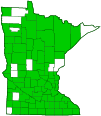eastern black nightshade
(Solanum emulans)
Conservation • Weed • Wetland • Description • Habitat • Ecology • Use • Distribution • Taxonomy
Description |
||
Eastern black nightshade is a 6″ to 24″ tall, erect, annual forb that rises from a slender taproot. The stems are erect and branching and are covered with short, incurved hairs, especially near the top. The leaves are alternate, egg-shaped to triangular, and ¾″ to 3″ long, ⅜″ to 2″ wide, on long, slender leaf stalks. The margins have 2 to 5 irregular, blunt teeth on the lower half, no teeth on the upper half. There are scattered, short, incurved hairs on the upper and lower surfaces, especially on the lower surface. The underside is green when young, turning purplish or purple with age. The inflorescence is an umbrella-shaped cluster of 3 to 10 flowers on an ascending stalk (peduncle) up to 1⅛″ long arising from the upper portion of the stem, not from leaf axils, and not at the end of the stem. The individual flowers are on nodding, closely-clustered stalks that originate at more or less the same point at the end of the peduncle. The peduncle and the individual flower stalks are covered with short, incurved hairs. The flowers are from less than ¼″ to ⅓″ wide. There are 5 white petals that are widely spreading, eventually curving backward, and form no tube at the base. There are 5 stamens with large yellow anthers projecting from the center of the petals. The anthers converge around the style but are not actually fused together. The fruit is a berry, green and mottled when young, black or purplish black when ripe. At the base of the fruit the sepals (calyx) has 5 bluntly triangular lobes that are spreading and do not cup the berry. |
||
Height |
||
6″ to 24″ |
||
Flower Color |
||
White |
||
Similar Species |
||
| Common lamb’s-quarters (Chenopodium album) leaves are whitish on the underside, not purplish. | ||
Habitat |
||
Rocky and dry open woods, thickets, openings, lake shores. Disturbed and cultivated areas. |
||
Ecology |
||
Flowering |
||
June to October |
||
Pests and Diseases |
||
|
||
Toxicity |
||
The leaves and immature berries are poisonous. Ripe berries are not poisonous but should not be eaten. |
||
Use |
||
|
||
Distribution |
||||
|
Sources |
|||
| 2/7/2023 | ||||
Nativity |
||||
Native |
||||
Occurrence |
||||
Common |
||||
Taxonomy |
|||
| Kingdom | Plantae (Plants) | ||
| Division | Tracheophyta (Vascular Plants) | ||
| Subdivision | Spermatophytina (Seed Plants) | ||
| Class | Magnoliopsida (Dicots) | ||
Order |
Solanales (nightshades, bindweeds, gooseweeds, and allies) | ||
Family |
Solanaceae (nightshade) | ||
| Subfamily | Solanoideae (nightshades and allies) | ||
| Tribe | Solaneae (nightshades and jaltomatas) | ||
Genus |
Solanum (nightshades) | ||
| Subgenus | Solanum | ||
| Section | Solanum | ||
In the late 19th and early 20th centuries, the black nightshade in eastern North America was classified as a single widespread and highly variable species Solanum nigrum. Later it was classified (by some) as Solanum ptychanthum, occurring throughout eastern North America. More recently, it was classified as Solanum emulans, and Solanum ptychanthum is treated as a synonym of Solanum americanum, a species occurring in the United States only in the extreme south and on the West Coast. Today (2023) there is widespread agreement that Solanum nigrum is the wrong name, but there is little agreement on the correct name.
|
|||
Subordinate Taxa |
|||
|
|||
Synonyms |
|||
Solanum alatum Solanum americanum (misapplied) Solanum nigrum (misapplied) Solanum nigurm var. virginicum Solanum ptycanthum (misapplied misspelling) Solanum ptychanthum (misapplied) |
|||
Common Names |
|||
black nightshade common nightshade deadly nightshade nightshade eastern black nightshade eastern nightshade purple nightshade small-flowered nightshade West Indian nightshade |
|||
Glossary
Axil
The upper angle where the leaf stalk meets the stem.
Calyx
The group of outer floral leaves (sepals) below the petals, occasionally forming a tube.
Peduncle
The stalk of a single flower or flower cluster.
Visitor Photos |
|||||
Share your photo of this plant. |
|||||
| This button not working for you? Simply email us at info@MinnesotaSeasons.com. Attach one or more photos and, if you like, a caption. |
|||||
|
|||||
MinnesotaSeasons.com Photos |
|||||
Inflorescence |
|||||
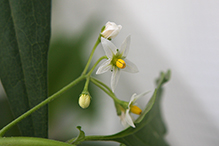 |
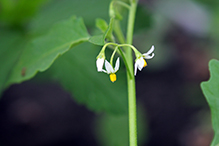 |
||||
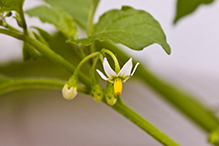 |
|||||
Leaves |
|||||
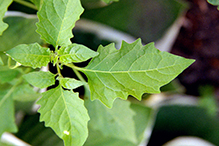 |
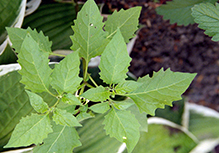 |
||||
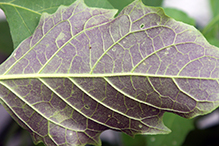 |
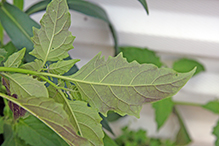 |
||||
Stem |
|||||
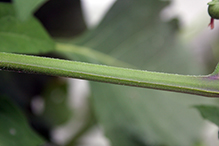 |
|||||
Infructescence |
|||||
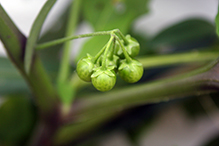 |
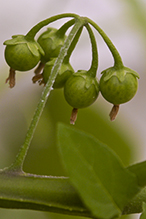 |
||||

Slideshows |
||

Visitor Videos |
|||
Share your video of this plant. |
|||
| This button not working for you? Simply email us at info@MinnesotaSeasons.com. Attach a video, a YouTube link, or a cloud storage link. |
|||
Other Videos |
|||
| Nightshade Weeds ID1 crop4240 |
|||
About
Published on Oct 29, 2012 Common Name: Eastern Black Nightshade Latin Name: Solanum ptychantum (L.) |
|||
| Black Nightshade Harvest karlweir |
|||
About
Uploaded on Dec 4, 2011 Harvesting Black Nightshade from the garden. When to harvest and why. |
|||
| European Black Nightshade (Solanum Nigrum) - 2012-09-02 W3stlander |
|||
About
Published on Sep 5, 2012 Solanum nigrum (European Black Nightshade or locally just "black nightshade", Duscle, Garden Nightshade, Hound's Berry, Petty Morel, Wonder Berry, Small-fruited black nightshade or popolo) is a species in the Solanum genus. ----------------- |
|||
| Weed of the Week #651-Black Nightshade (Air Date 9/26/10) AgPhD |
|||
About
Uploaded on Oct 1, 2010 Nasty to deal with at harvest, it's our Weed of the Week, Black Nightshade. |
|||
| Eastern Nightshade Wild Plant wayne hu |
|||
About
Published on Sep 7, 2013 This is an weed that grown wildly in my yard. It is a poisonous plant that can cause irritation of digest system if ingested. It belongs to Nightshade family just like tomatoes do. |
|||

Visitor Sightings |
|||||
Report a sighting of this plant. |
|||||
| This button not working for you? Simply email us at info@MinnesotaSeasons.com. Be sure to include a location. |
|||||
|
|||||
MinnesotaSeasons.com Sightings |
|||||

|
Created: Last Updated: © MinnesotaSeasons.com. All rights reserved. |
